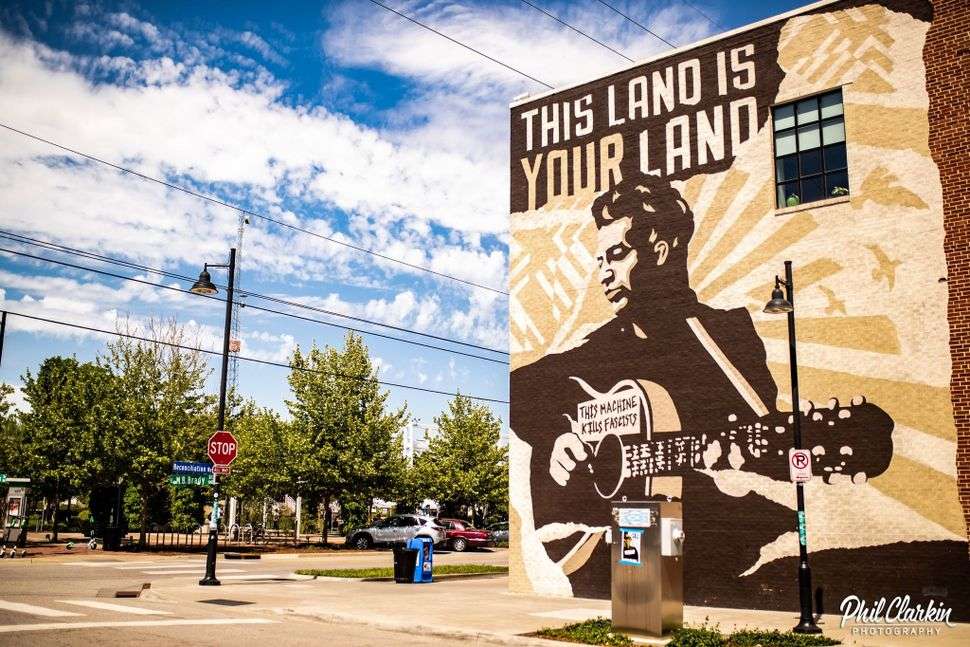A Book Review of “Woody Guthrie: An Intimate Life” by Gustavus Stadler
Woody Guthrie knew hard traveling. He traveled on fast, rattling box cars and hitchhiked across the USA in the midst of the Depression. He organized farm workers in Hooverville shanty-towns and sang for miners and factory workers on the picket lines. He always sang and played on his guitar. Woody’s goal was to build the movement through exposing the evils of capitalism and by celebrating life through music and dance. He embodied Emma Goldman’s saying, “If I can’t dance, I don’t want to be in your revolution.”
Woody was in perpetual motion. He wrote in a notebook continuously: songs, poems, sketches, two published novels, stream-of-consciousness pieces about racism, poverty, capitalism, his moods, his loves and sex life and fascism. He was creating constantly at a breakneck speed. It was as if he understood in his gut that his time would be limited. His mother suffered from Huntington’s Disease. The local authorities in Okemah, OK put her in an asylum when Woody was a teenager. The same disease overtook Woody soon after he turned 40, but it didn’t stop his songwriting.
Like every one of us, Guthrie was strongly influenced by the class and racial contradictions he grew up with. The son of a small town Democratic political operative, he was 17 when the Depression struck. The economic catastrophe was followed by an environmental one: a terrible drought and dust storms that ruined thousands of farmers from Oklahoma and Texas to Montana and Minnesota. The drought was natural but capitalist settler-colonialism plowed up the prairies of the Great Plains and planted seeds for profit. Destruction of the prairie ecosystem caused the dust storms. Woody took in these events and turned his talents to organizing through songs, music, spoken word and even dance.
While Woody is celebrated as a great American folk singer, what is unique about Guthrie is his lifelong class stand. He and Paul Robeson were two musical superstars of their day who stood against the Red Scare and never denounced socialism or their comrades in the Communist Party USA. They were only two cultural creators among thousands who were part of the Popular Front cultural movements that formed a foundation for anti-fascist movements around the world. The Popular Front was a political alliance of communist and socialist parties in Latin America, Canada, the United States and Europe. But it was much more than a political alliance. The politics were based on organizing labor and tenant unions, Unemployed Councils, women’s associations and farm groups and it went even deeper than that. The Popular Front encompassed a massive cultural movement that included famous novelists such as Steinbeck, opera singers, dancers, actors, poets and musicians. In the United States the political activists of the CP, Socialist Party and New Deal Democrats were constantly battling each other. But the cultural movement provided a space for all progressives to come together for engaged enjoyment and camaraderie. It also drew apolitical people into the working class movement and educated them as they were dancing to music or watching a play.
Culture is not a superficial aspect of capitalism. Culture conditions us to think and act as we do. It recreates racist attitudes and enforces patriarchal relationships. Culture reproduces individualism and strivings for domination. But we can learn from how Woody, Pete Seeger, Odetta, Leadbelly and others used popular songs to refresh tired, oppressed workers with the rhythms of a better world. In 2022, Twin Cities DSA members launched a socialist poetry zine. Maybe in 2023 we can have socialist music jams or open mics. Maybe we could collaborate with Black or indigenous theater groups. Your imagination, creativity and organizing skills are the only limits.
By Robbie O.

